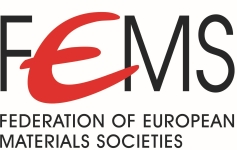The FEMS Lecturers 2009
Lyubov Belov
Dept. of Materials Science and Engineering, Royal Institute of Technology, Stockholm, Sweden
 Born in 1974 in Moscow (Russia), in 1996 Lyobov graduated with honors from Moscow Institute of Physics and Technology. She completed her PhD in 2000 in the field of “Colossal Magnetoresistance materials”. In 1998 her research work was selected as “Best research in the Low Temperature Physics” by the Russian Academy of Sciences and in 2001 she received a “Best young scientists of Russia” award.
Born in 1974 in Moscow (Russia), in 1996 Lyobov graduated with honors from Moscow Institute of Physics and Technology. She completed her PhD in 2000 in the field of “Colossal Magnetoresistance materials”. In 1998 her research work was selected as “Best research in the Low Temperature Physics” by the Russian Academy of Sciences and in 2001 she received a “Best young scientists of Russia” award.
After finishing her PhD she joined Royal Institute of Technology (Sweden) as a postdoc and in 2004 has received a “Senior researcher” Assoc. Prof. equivalent position from the Swedish Research Council. In 2005 she was selected as a “Future Research Leader” by the Swedish Foundation for Strategic Research. She is now leading the “Engineering Materials Physics” group at the Department of Materials Science and Engineering of the Royal Institute of Technology. The group is mainly involved in design of new functional materials for magnetoelectronic and spintronics applications, nano-to-micro scale patterning and component design.
InkJet technology for flexible patterning of functional materials
With the development of nanoscience and methods of design and fabrication of nanomaterials the availability of inexpensive easy to use tools capable of large area patterning of nanoscale materials and structures is becoming increasingly important. InkJet technology has been developing rapidly over the last decade for high-resolution photo printing and has now expanded into patterning of functional materials.
Piezoelectrically driven InkJets operate at room temperature in ambient conditions and thus are compatible with a wide variety of materials from ceramic and magnetic nanoparticles to carbon nanotubes and proteins. A variety of substrates from paper to glass and plastics can be used. Some of our recent developments are related to direct patterning of oxides (e.g. ZnO, MgO) for optics and magneto-optic components. One of the targeted applications is UV sensing.
Carlo Mapelli
Department of Mechanics, Politecnico di Milano, Italy
 Prof. Eng. Carlo Mapelli was born at Inzago (MI) on 23-10-1973 and graduated in Materials Engineering at Politecnico di Milano in October 1998. In January 1999 he passed the qualification for the admission to the PhD in Metallurgical Engineering at Politecnico di Torino. In March 2001 he became a Researcher in the scientific area designated ING IND/21 in the Section of Materials of the Department of Mechanics at Politecnico di Milano. In 2002 he was awarded the Daccò Prize of the Italian Association of Metallurgy (AIM) for his researches aimed at the understanding of the microsegregative phenomena in free-cutting steels. In January 2003 he obtained his PhD in Metallurgical Engineering at Politecnico di Torino for researches concerning the problems connected to the plastic deformation of metals. In March 2005 he became Associate Professor in the Dipartimento di Meccanica - Politecnico di Milano where he presents the courses: Steelmaking, Metallurgical technologies, Plastic deformation of metals, and Metallurgy.
Prof. Eng. Carlo Mapelli was born at Inzago (MI) on 23-10-1973 and graduated in Materials Engineering at Politecnico di Milano in October 1998. In January 1999 he passed the qualification for the admission to the PhD in Metallurgical Engineering at Politecnico di Torino. In March 2001 he became a Researcher in the scientific area designated ING IND/21 in the Section of Materials of the Department of Mechanics at Politecnico di Milano. In 2002 he was awarded the Daccò Prize of the Italian Association of Metallurgy (AIM) for his researches aimed at the understanding of the microsegregative phenomena in free-cutting steels. In January 2003 he obtained his PhD in Metallurgical Engineering at Politecnico di Torino for researches concerning the problems connected to the plastic deformation of metals. In March 2005 he became Associate Professor in the Dipartimento di Meccanica - Politecnico di Milano where he presents the courses: Steelmaking, Metallurgical technologies, Plastic deformation of metals, and Metallurgy.
His scientific activity has focused on the following subjects:
- thermodynamic and kinetics of the steelmaking processes
- solidification of metallic materials
- study of the thermodynamic cycles of metallic materials and their working technologies
- features of archeometallurgical products
- failure analysis.
New opportunities for improving the formability of duplex stainless steels through specifically designed thermo-mechanical processes
A weakness of duplex stainless steels is their poor formability, which is due to a strong tendency towards thinning. Specifically designed laboratory rolling trials have been undertaken at different temperatures on 2205 duplex steel grades subjected to different reduction ratios and possible solution quenching. The rolling operations have been performed in symmetric and asymmetric conditions in order to impose different straining on the bulk regions of the laminated sheets.
The mechanical properties, the microstructural features and the texture characteristics have been defined for each condition and discussed on the basis of the results of finite element simulations performed using a Navier-Stokes approach. Such an approach allows clarification of the stress and strain field induced in the rolled product. Promising results for the design of steel microstructures for future industrial applications have been obtained and will provide improved control of the mechanical properties of duplex stainless steels.

